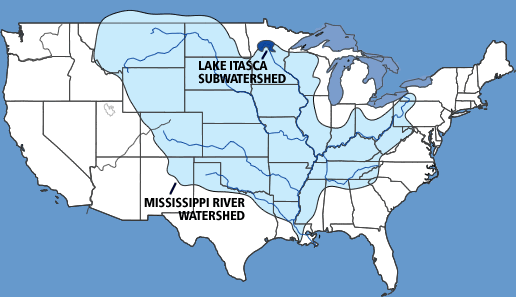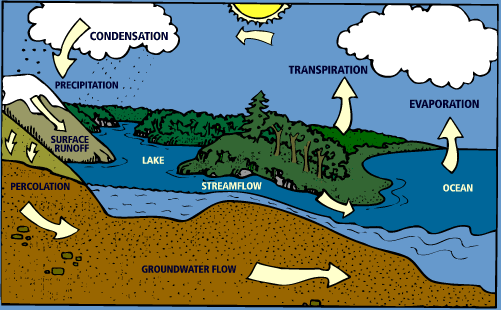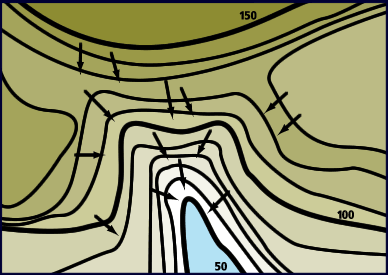 |
 |
IN A WATERSHED
- What is a watershed?
- Why should I care about watersheds?
- What are the sources of water to lakes and streams?
- How do watershed managers determine watershed boundaries?
- Who can I contact if I have questions or a problem related to watersheds?
- What are some additional resources related to watersheds?
What is a watershed?
A watershed, also called a drainage basin, is all of the land and water areas that drain toward a particular river or lake. Thus, a watershed is defined in terms of each selected lake (or river). Large watersheds are composed of smaller areas called subwatersheds. For example, the Mississippi River has an extremely large watershed, encompassing most of the central United States. Lake Itasca, Minnesota, on the other hand, has a small watershed. As the source of the Mississippi River, Lake Itasca's drainage basin is considered a sub-watershed of the entire Mississippi River basin.

Why should I care about watersheds?
The water quality of your lake is affected by activities upstream or upland of the lake within the watershed, so it is important to know the geographic area encompassed by the watershed surrounding your lake. Especially important are the watershed processes that affect how water, sediment and other materials get transported to the lake. Looking at both natural processes and human influences from a watershed perspective is vital for dealing with concerns such as lakes that are unsafe for swimming or declining fish stocks. Check out the Environmental Protection Agency watershed web site (http://www.epa.gov/OWOW/watershed/) to learn more about watersheds and why it is important to know about them.What are the sources of water to lakes and streams?
Water runs over land surfaces (overland flow) and into stream channels when it rains, when snow melts, or during irrigation. Water also seeps into and through the soil and underground (groundwater flow). Groundwater does not necessarily always follow the same watershed boundaries as surface water. In fact, groundwater flowing into lakes can sometimes originate from outside the watershed. Plants intercept water on their leaves and take up water from the soil. Land uses can alter the natural flows of water. Impervious surfaces such as parking lots, roads, and rooftops increase the velocity and amount of stormwater flow into lakes and rivers.
How do watershed managers determine watershed boundaries?
Watershed managers use topographic maps to identify ridges and other high points that separate one watershed from another. Topographic maps show the contours of the land's surface. By connecting the high points on the map, managers include all the drainage that flows into a lake and exclude any drainage flowing away from the lake. U.S. Geological Survey (USGS) topographic maps are available from bookstores, libraries, and can be ordered from USGS Information Services (1-800-USA-MAPS or http://mapping.usgs.gov/esic/to_order.html). The Land Information Management Center has maps online that allow you to view major watersheds and subwatersheds at the "Index of Minnesota Watersheds" (http://www.lmic.state.mn.us/dnet/maplib/climate/mnsflow/wsindex.htm). The Minnesota Department of Natural Resources also has watershed maps online at http://www.dnr.state.mn.us/waters/rivers_and_streams/wsheds.html.
Who can I contact if I have questions or a problem related to watersheds?
Check your local listing, the Minnesota Shoreland Management Resource Guide Web site, www.shorelandmanagement.org, or the Web site for:
- Your county Soil and Water Conservation District (SWCD)
- Your county Water Plan Coordinator
- Minnesota Department of Natural Resources (MDNR) www.dnr.state.mn.us
- Your county Planning and Zoning
- United States Geological Survey (USGS) www.usgs.gov
What are some additional resources about watersheds?
- Shoreland Landscaping Series: A guide to natural landscaping and revegetation for enhancing lake quality. 1999. University of Minnesota Extension Service, St. Paul
- A Citizen's Guide to Lake Protection. 1985. Minnesota Pollution Control Agency and Freshwater Foundation
- A User's Guide to Shoreland Property. 1999. Aitkin County and the Mississippi Headwaters Board
- Minnesota Lake And Watershed Data Collection Manual. 1994. Minnesota Pollution Control Agency

